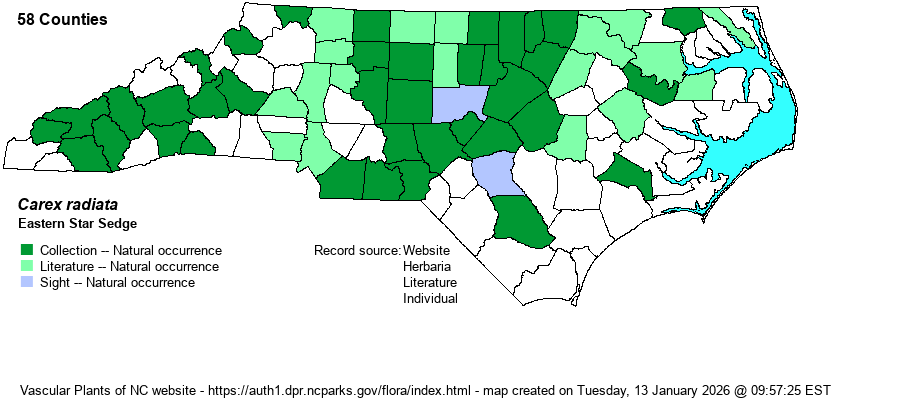| Author | (Wahlenberg) Small | |
| Distribution | Mountains and Piedmont (with a gap in the western Piedmont); scattered in the Coastal Plain, mostly along brownwater rivers. The gap in the Piedmont is likely to disappear with additional collecting.
N.S. to Man., south to GA, LA, OK. | |
| Abundance | Frequent to locally common in the Mountains and Piedmont, except oddly scarce in the western Piedmont. Rare in the Coastal Plain, near brownwater rivers. Populations often are robust, with hundreds of plants which form patches via short rhizomes. Because of confusion between this species and C. rosea (see below), there may well be additional collections in herbaria under that name. The website editors give a State Rank of S4. | |
| Habitat | Floodplain forests and bottomlands, forested creeksides. |
| Phenology | Flowering and fruiting late April-June. | |
| Identification | Eastern Star Sedge is closely related to C. rosea and C. appalachica. It differs from them by its usually slightly coiled stigmas, seen even when in fruit (vs. usually tightly coiled). From C. socialis, told by shorter achenes (1.5-2.0 mm vs. 1.8-2.3 mm in C. socialis) and short rhizomes (vs. very elongate). | |
| Taxonomic Comments | Formerly, the name C. rosea was misapplied to C. radiata, causing much confusion.
The genus Carex is the largest in North America, and among the largest in the world. In temperate and boreal regions, Carex is often the dominant or co-dominant ground layer in many habitats. Seeds (achenes) are valuable food for birds and small mammals, while foliage is used by birds and mammals to make nests and as food by mammals. Species of Carex often look vastly different from one another -- spikes erect vs. drooping, tiny inflorescence vs. whopping, culms leafy vs. naked, perigynia beaked vs. beakless, stems densely bunched vs. single, etc. The genus has been divided into many sections (or groups), based on shared characters; some taxonomists have suggested that these be different genera, but that proves unworkable (so far). All Carex share the feature of a perigynium (an outer covering) which completely surrounds the achene (seed). This covering may fit tightly or loosely (like a small bladder), depending on which group or species. Details of perigynia shape, ornamentation, presence and size of beak, number of striations (or veins) are all important ID features. In recent years Rob Naczi and colleagues have stressed the importance of arrangement of perigynia -- whether spiral (3+ ranks) or distichous (2-ranked) -- and have named a number of new species as well as split off some older synonyms. Therefore, RAB's (1968) key, excellent for its time, can only be used in a general way today. Members of some sections of Carex are difficult to key out (notably Ovales, Laxiflorae, Griseae); this is in part due to variation among individuals of a species, or failings of the key. FNA has drawings of most species and some species may be found in two or more places within a key, to acount for variability. New species to NC, and new to science(!), continue to be found in NC. | |
| Other Common Name(s) | Star Sedge (the common name usually given to C. echinata) | |
| State Rank | [S4] | |
| Global Rank | G4 | |
| State Status | | |
| US Status | | |
| USACE-agcp | FAC link |
| USACE-emp | FAC link |

